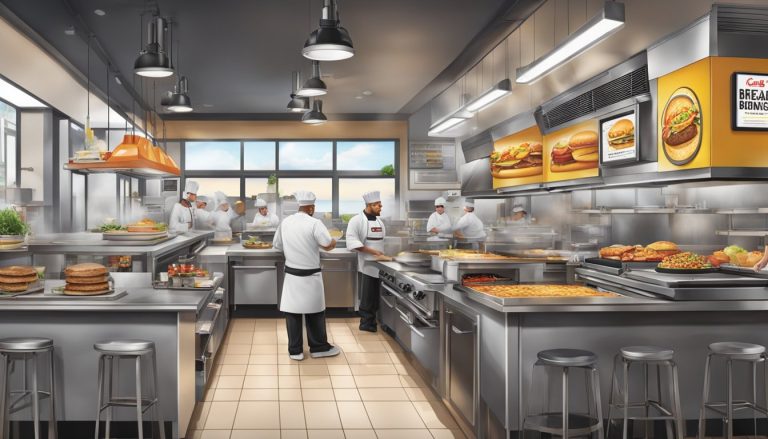Carl’s Jr., a prominent fast-food chain, has taken significant strides toward sustainability in recent years. The company’s efforts extend beyond menu innovations to encompass eco-friendly operational practices and restaurant design. In 2025, Carl’s Jr. continues to expand its green initiatives, with a particular focus on creating sustainable breakfast options for environmentally conscious consumers.
These efforts build upon earlier steps taken by the company, including the launch of its first “green” restaurant in Carpinteria, California. This location served as a testing ground for energy conservation measures and efficient operational strategies. Carl’s Jr. has also partnered with plant-based meat alternatives to offer more sustainable menu choices, reflecting a growing trend in the fast-food industry.
The company’s commitment to sustainability aligns with changing consumer preferences and industry trends. By incorporating eco-friendly practices and menu items, Carl’s Jr. aims to appeal to a broader customer base while reducing its environmental impact. These initiatives may help the chain maintain a competitive edge in an increasingly crowded and environmentally aware market.
Carl’s Jr. and the Fast-Food Landscape

Carl’s Jr. operates in a highly competitive fast-food industry, facing challenges from both traditional rivals and emerging fast-casual brands. The company has evolved its strategies to maintain relevance and appeal to changing consumer preferences.
Fast-Food Industry Overview
The fast-food industry is characterized by intense competition and rapid evolution. Major players like McDonald’s, Burger King, and Wendy’s dominate the market, while newer entrants like Five Guys and Shake Shack disrupt traditional models.
Fast-food chains face pressure to offer healthier options, improve sustainability practices, and embrace technology. Many have introduced plant-based menu items and digital ordering systems to meet changing consumer demands.
The industry has seen a shift towards value menus and combo deals to attract price-conscious customers. At the same time, there’s a growing focus on premium ingredients and customization to appeal to more discerning diners.
Carl’s Jr.’s Place in the Market
Carl’s Jr. positions itself as a premium fast-food burger chain, known for its charbroiled burgers and provocative marketing campaigns. The company has worked to differentiate itself through larger portion sizes and higher-quality ingredients.
In recent years, Carl’s Jr. has pivoted towards more sustainable practices. They introduced plant-based burgers in partnership with Beyond Meat, catering to the growing demand for meat alternatives.
The chain has also experimented with new menu items and limited-time offers to stay competitive. Carl’s Jr.’s target demographic skews towards young adult males, influencing its marketing and product development strategies.
Competitive Landscape and Co-Branding with Hardee’s
Carl’s Jr. faces stiff competition from other burger-focused chains like McDonald’s, Burger King, and Wendy’s. To expand its reach, Carl’s Jr. has a unique co-branding arrangement with Hardee’s.
While Carl’s Jr. primarily operates in the western United States, Hardee’s covers the eastern and midwestern regions. This partnership allows the company to have a national presence under two distinct brands.
The menus of Carl’s Jr. and Hardee’s share many similarities, with some regional variations. This co-branding strategy helps the company compete more effectively against national chains while maintaining regional brand loyalty.
A Green Revolution in Breakfast Options

Carl’s Jr. has embraced plant-based alternatives and sustainability in its breakfast offerings. The fast food chain now provides more eco-friendly choices to meet evolving consumer preferences.
Introducing the Beyond Famous Star
Carl’s Jr. partnered with Beyond Meat to launch the Beyond Famous Star burger. This plant-based patty mimics the taste and texture of beef while using fewer resources. The Beyond Famous Star contains 20 grams of plant protein and has no cholesterol.
Carl’s Jr. became one of the first major fast food chains to offer a plant-based burger nationwide. This move helped attract new customers seeking meat alternatives. The Beyond Famous Star quickly became a popular menu item.
Extending the Vegan Menu
Building on the success of the Beyond Famous Star, Carl’s Jr. expanded its vegan options. The chain introduced the Beyond Sausage Burrito and Beyond Sausage Egg & Cheese Biscuit for breakfast. These items cater to vegans and those looking to reduce meat consumption.
Carl’s Jr. also offers veggie burgers and other plant-based sides. A vegan menu guide helps customers identify animal-free options easily. This expanded selection demonstrates Carl’s Jr.’s commitment to meeting diverse dietary needs.
Sustainable Competitive Advantage
By embracing plant-based options, Carl’s Jr. has positioned itself as a leader in sustainable fast food. This strategy helps differentiate the chain from competitors and attract environmentally-conscious consumers.
The focus on sustainability extends beyond menu items. Carl’s Jr. has worked to reduce packaging waste and improve energy efficiency in its restaurants. These efforts create a more sustainable business model and appeal to eco-friendly customers.
Carl’s Jr.’s green initiatives have helped the company stay relevant in a changing market. By adapting to new consumer preferences, the chain has maintained its competitive edge in the fast food industry.
Operational Excellence for Sustainability
Carl’s Jr. has implemented several strategies to enhance operational efficiency while prioritizing sustainability. These efforts focus on green operations management, adapting processes for expansion, and leveraging online ordering systems.
Incorporating Green Operations Management
Carl’s Jr. has integrated eco-friendly practices into its daily operations. The company has installed energy-efficient lighting and appliances in its restaurants, reducing electricity consumption. Water-saving fixtures have been implemented to minimize water usage.
Waste reduction initiatives include recycling programs for packaging materials and food waste composting. The restaurant chain has also switched to biodegradable utensils and containers where possible.
Staff training programs emphasize sustainable practices, ensuring employees understand and follow green protocols. Regular audits help identify areas for improvement in resource management and environmental impact reduction.
Adapting Business Operations for Expansion
As Carl’s Jr. expands, it has developed scalable sustainability practices. The company utilizes modular restaurant designs that incorporate green building materials and energy-efficient systems. This approach allows for faster construction while maintaining environmental standards.
Supply chain optimization has been a key focus. Carl’s Jr. works with local suppliers to reduce transportation emissions and support regional economies. The company has also implemented inventory management systems to minimize food waste.
Franchisee guidelines now include sustainability requirements, ensuring consistent eco-friendly practices across all locations. This standardization helps maintain operational excellence while supporting environmental goals.
The Role of Online Ordering in Sustainability
Carl’s Jr. has embraced digital technology to enhance sustainability efforts. The company’s online ordering system reduces paper waste from printed menus and receipts.
Mobile app features allow customers to customize orders, reducing food waste from unwanted items. The app also provides real-time data on ingredient availability, helping optimize inventory management.
Delivery partnerships utilize route optimization algorithms to minimize fuel consumption and emissions. Carl’s Jr. encourages customers to opt for eco-friendly packaging options when ordering online, further reducing environmental impact.
Marketing and Target Audience Engagement

Carl’s Jr.’s marketing strategy for sustainable breakfast focuses on appealing to diverse age groups while balancing provocative messaging with eco-friendly initiatives. The brand aims to maintain its familiar quality image while attracting environmentally conscious consumers.
Targeting Millennials and Baby Boomers
Carl’s Jr. tailors its sustainable breakfast marketing to both millennials and baby boomers. For millennials, the company emphasizes eco-friendly packaging and locally sourced ingredients on social media platforms. The brand uses Instagram and TikTok to showcase visually appealing, sustainable breakfast options.
Baby boomers are targeted through traditional media channels like television and print ads. These campaigns highlight the nutritional benefits of Carl’s Jr.’s sustainable breakfast items, appealing to health-conscious older consumers.
The company also utilizes cross-generational marketing tactics, such as featuring multi-generational families enjoying sustainable breakfast options together in advertisements.
Balancing Provocative Ads with a Sustainable Image
Carl’s Jr. faces the challenge of maintaining its edgy brand identity while promoting sustainability. The company has moved away from overtly provocative ads, instead focusing on subtle humor and clever wordplay to promote its sustainable breakfast menu.
Marketing campaigns now feature catchy slogans like “Green Eggs and Ham Done Right” or “Sustainability Never Tasted So Good.” These messages retain a hint of the brand’s cheeky personality while emphasizing its commitment to eco-friendly practices.
Carl’s Jr. also partners with popular eco-conscious influencers to create content that blends sustainability with the brand’s signature bold style.
Brand Familiarity and Quality Perceptions
Carl’s Jr. leverages its established reputation for quality to promote its sustainable breakfast options. The company emphasizes that its commitment to sustainability enhances, rather than compromises, the taste and quality of its food.
Marketing materials highlight the use of premium, sustainably sourced ingredients in familiar breakfast items. For example, ads may feature the phrase “Same great taste, now with cage-free eggs” to reassure customers of consistent quality.
The brand also conducts in-store taste tests and offers samples of sustainable breakfast items to reinforce positive quality perceptions. Customer testimonials praising the taste and eco-friendly aspects of the new menu are prominently featured in marketing campaigns.
Assessment of Consumer Behaviors

Consumer behaviors in fast-casual dining are evolving, with sustainability and health-conscious options gaining traction. Customers increasingly consider environmental impact and dietary preferences when making purchase decisions.
Purchase Consideration in Fast-Casual Dining
Price and convenience remain key factors in fast-casual dining choices. However, sustainability efforts now play a role in purchase decisions. Consumers are more likely to choose restaurants that demonstrate environmental responsibility.
Carl’s Jr.’s green initiatives may appeal to eco-conscious customers. The chain’s sustainable breakfast options could attract those seeking environmentally friendly meal choices. Brand image and perceived environmental commitment influence consumer preferences.
Food Expenditures and Vegan Options
Consumer spending on plant-based and vegan options is rising. Many customers are willing to pay more for sustainable and healthier menu items. This trend aligns with Carl’s Jr.’s efforts to expand its vegan breakfast offerings.
Vegan menu options can attract a broader customer base, including health-conscious and environmentally aware diners. By introducing plant-based alternatives, Carl’s Jr. may capture a growing market segment. The availability of vegan choices can influence food expenditures and dining preferences among both vegan and non-vegan customers.
International Strategy and Market Penetration

Carl’s Jr. has pursued an ambitious global expansion strategy, leveraging its brand recognition and product offerings to enter new markets. The company has adapted its approach to cater to local tastes while maintaining its core identity.
Challenges and Opportunities in New Markets
Carl’s Jr. faces unique challenges in each new market it enters. Cultural differences and varying consumer preferences require careful menu adaptations. In Asia, the company introduced rice bowls and localized flavors to appeal to regional tastes. Regulatory hurdles and competition from established local chains pose additional obstacles.
Despite these challenges, international markets offer significant growth potential. Carl’s Jr. has seen success in Mexico, Central America, and Southeast Asia. The brand’s premium image and made-to-order burgers differentiate it from competitors. Carl’s Jr. targets young, urban consumers seeking higher-quality fast food options.
To gain a competitive advantage, Carl’s Jr. emphasizes its charbroiled burgers and customizable menu. The company also adapts its marketing strategies to resonate with local audiences. In some markets, Carl’s Jr. partners with local franchisees to navigate cultural nuances and distribution networks more effectively.
Menu Innovation and Diversification

Carl’s Jr. has expanded its breakfast offerings beyond traditional burgers to include more sustainable and diverse options. The company aims to cater to evolving consumer preferences while minimizing environmental impact.
Beyond the Burger: Hash Browns and Crisscut Fries
Carl’s Jr. introduced crispy hash browns as a popular breakfast side. These golden potato bites offer a satisfying crunch and complement other morning menu items.
The chain also features Crisscut Fries, a unique take on traditional french fries. Their waffle-like shape provides more surface area for crispiness while using less oil in the cooking process.
Both hash browns and Crisscut Fries are made from locally sourced potatoes when possible, reducing transportation emissions. The company has also explored using recyclable packaging for these items.
The Impact of Condiments on Eco-Friendly Menus
Condiments play a crucial role in Carl’s Jr.’s sustainable breakfast initiative. The chain has partnered with suppliers to source eco-friendly ketchup and mustard options.
These condiments now come in biodegradable packets, reducing plastic waste. Carl’s Jr. has also implemented pump dispensers in some locations to minimize individual packet usage.
The company is exploring plant-based alternatives for mayo and other sauces to appeal to vegan customers. Drinks are served in recyclable cups, with some locations offering reusable cup discounts.
Carl’s Jr.’s partnership with Green Burrito has introduced salsa as a breakfast condiment option, adding flavor variety while using locally sourced ingredients where feasible.




